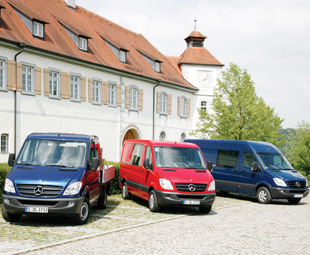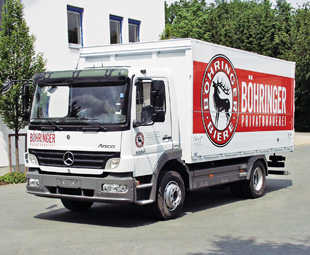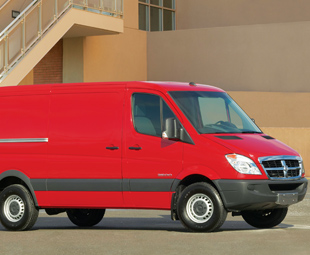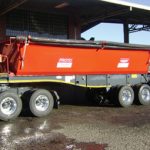The road to recovery

As the global recession claims more and more victims, the truck industry has had to come up with ways to stay afloat.
Readers of the quarterly review articles in FOCUS will be aware that the South African market for commercial vehicles over 3 500 kg gross vehicle mass (GVM), for the initial six months of 2009, was 48.2% of the total volume of sales recorded during the equivalent period one year earlier.
The cumulative total of 9 678 units reported during that half-year was also the lowest volume result for the first six months of any year since 2004, and marked the end of a period in which the market had experienced an unbroken run of seven years’ uninterrupted growth before reaching an all-time annual volume record of 37 067 units in 2007. Even the final 2008 total of 34 659 units, while not sustaining the upward trend, was still the second best ever calendar year volume in this market’s history.
Although it will provide no measure of comfort to the companies and individuals depending on this market for their livelihood, it is interesting to note that similar, and in some cases, worse, results have been recorded in major global markets. In the United States, for instance, retail sales of Class 8 trucks (above 15 t GVM) during the first half of 2009 fell by 33.4% compared to one year earlier, ending at a cumulative 43 457 units, while the equivalent January-June 2008 volume was 65 268 units. In Central Europe, the situation was considerably more serious, with the total truck market for vehicles over 3.5 t GVM, at 24 746 units, being 62.7% off the equivalent 2008 first-half volume of 66 363 units, while in Western Europe, the equivalent total market volume of 269 318 units was 37% down on the first-half 2008 result of 427 801 sales.
Deeper analysis of the Central European region, which consists of Poland, Romania, Hungary, Estonia, Lithuania, Latvia, Slovenia, Croatia, the Czech Republic and Slovakia, reveals that the biggest “hit” was taken by the heavy truck (over 16 t GVM) segment which was 74.7% down year-on-year, followed by medium trucks (6.1-15.9 t GVM) at 60.2% off, and light trucks (3.5 t to 6 t GVM) which lost 50.7% in the first half-year comparison. Of the individual LCV manufacturers, Mercedes-Benz, Fiat Auto and Volkswagen gained market share, while PSA Peugeot-Citroën, Ford and Renault VI gave up penetration in the falling market. In the MCV segment, the “winners” included MAN and Mercedes-Benz, while Iveco, Renault, DAF, Mitsubishi and Volvo lost ground, and in the premium payload division, there was good news for MAN, Mercedes-Benz and DAF, while Scania and Volvo lost traction in the difficult business conditions.
 In Western Europe, made up of France, Germany, Italy, Spain, the UK, Ireland, Belgium, Luxemburg, The Netherlands, Denmark, Finland, Norway, Sweden, Austria, Switzerland, Portugal and Greece, the top-mass heavy-duty units once again led the volume slide, losing nearly 41% in the year-on-year January-June comparison, while entry-level light trucks, at a 35.7% volume loss, were more seriously affected than the “mediums”, which gave up 30.6% of their first-half 2008 level (all GVM classes as for Central Europe). In the light-truck segment, momentum was gained by Ford and Fiat Auto, while Iveco, Renault and Volkswagen lost ground. In both the medium- and heavy-truck segments, Mercedes-Benz increased market share, while all other participating manufacturers maintained their penetration, or retreated.
In Western Europe, made up of France, Germany, Italy, Spain, the UK, Ireland, Belgium, Luxemburg, The Netherlands, Denmark, Finland, Norway, Sweden, Austria, Switzerland, Portugal and Greece, the top-mass heavy-duty units once again led the volume slide, losing nearly 41% in the year-on-year January-June comparison, while entry-level light trucks, at a 35.7% volume loss, were more seriously affected than the “mediums”, which gave up 30.6% of their first-half 2008 level (all GVM classes as for Central Europe). In the light-truck segment, momentum was gained by Ford and Fiat Auto, while Iveco, Renault and Volkswagen lost ground. In both the medium- and heavy-truck segments, Mercedes-Benz increased market share, while all other participating manufacturers maintained their penetration, or retreated.
The consistent placing of the heaviest payload vehicle classes at the head of the loss-leading positions in South Africa and the two European regions is significant, and suggests that financial institutions in many countries must have felt particularly nervous about financing “big-ticket” items when the global financial crisis was at its worst. However, it is also noteworthy that Mercedes-Benz performed consistently well, in terms of improved market share, in both European regions, as well as in South Africa, during the first half of 2009. This would indicate that Daimler Trucks has the ability to bring its financial leverage to bear when market conditions are at their toughest, thus setting an example that other commercial vehicle manufacturers need to urgently emulate.
NAVISTAR/CATERPILLAR JV GOES GLOBAL AS NC2
It’s now just over a year since the first reports of an emerging joint venture between two Illinois-based North American companies, Navistar International Corporation of Warrenville, and Caterpillar Inc, of Peoria, made headlines in the global media. The scope of the joint venture included the development of Caterpillar-branded, heavy-duty vocational trucks (i.e. for specific applications, such as road construction, civil engineering and oilfield operations) for the North American market, plus the formation of a dedicated operation to pursue global on-highway commercial truck opportunities outside of North America.
The first manifestation of this cooperation came in the news that Navistar would integrate Caterpillar’s C-15 diesel engine into its MaxxForce engine line-up, once the engine had been redeveloped to comply with the upcoming US EPA 2010 emission standards. This followed Caterpillar’s earlier announcement that it would withdraw from the supply of “loose” diesel engines to on-highway truck manufacturers after the implementation of EPA 2010, although it still intended to manufacture engines for the petroleum, marine, industrial and power-generating markets, as well as its own in-house construction and mining equipment. Later this year, the new Caterpillar-branded North American trucks will be unveiled, and production of these units is scheduled to commence at Navistar’s Garland, Texas, facility in 2011. Distribution and servicing will be handled by Caterpillar’s domestic dealer network, and will be facilitated by the incorporation of selected common componentry also to be found in Caterpillar’s off-road product range.
The latest development in the roll-out of the Navistar/Caterpillar partnership is the establishment of NC2 Global LLC, a new 50/50 joint venture company that is to execute that portion of the strategy involving penetration of the global commercial truck market. The company will be headed up by Al Saltiel, as president, who has previous marketing experience at Sony, Jaguar and Ford, and a management team with members drawn from the executive ranks of both partners. NC2 has been set the objective of “producing and marketing a full line of commercial on-highway trucks for markets outside of North America”, and will sell a range of conventional and cab-over (normal and forward control) designs under both Cat and International branding. Initial target markets have been identified in Australia, Brazil, China, Russia, South Africa and Turkey.
There have also been media reports that Caterpillar and Navistar are in talks with Jianghuai Automobile Company about setting up a medium-/heavy-truck and engine joint venture in China (one of the target markets identified above). The reports say this will be 50% owned by Jianghuai, with the balance split between the two American companies. Jianghuai would bring its production facilities to the table, while Navistar and Caterpillar would contribute capital and technology.
TRUCKING RAMIFICATIONS OF THE CHRYSLER/FIAT ALLIANCE
Earlier this year, Chrysler LLC in the United States entered a seven-week process of Chapter 11 Bankruptcy Protection, which, in turn, gave birth to a new company named Chrysler Group LLC. As had been widely predicted, the Fiat Group emerged as an immediate 20% shareholder in the new Chrysler Group, with an agreement that the Italian manufacturer would progressively grow its shareholding to 35%, and provide management expertise, resources, technology and worldwide distribution as a vital part of the restructuring process. The combination of Fiat and Chrysler was reported to have become the world’s sixth-largest vehicle manufacturer, placed between Honda in fifth position and Hyundai/Kia in seventh, whereas stand-alone Chrysler had previously occupied ninth place prior to the merger, and Fiat 10th.
The immediate trucking ramifications of this new relationship were not particularly substantial, given that Chrysler, in recent years, had a fairly limited involvement in heavier commercial vehicles, while the Fiat Group’s major truck operation, Iveco, has focused most of its North American attention on supporting imported proprietary engines. However, Chrysler’s earlier association with Daimler, which has been progressively winding down since the 2007 dissolution of the DaimlerChrysler “marriage”, did leave some unfinished business with regard to the Sprinter van product line. Since 2004, Sprinters have been sold in North America with Dodge branding, as well as through Daimler Trucks’ Freightliner distribution channel. However, this is now set to change, and come January, 2010, Sprinters will only be available in the US with Freightliner or Mercedes-Benz badging.
 This decision has led to the establishment of Daimler Vans USA LLC, in Montvale, New Jersey, to carry the responsibility for Sprinter distribution and product support in North America. The Sprinter range has been marketed in North America since 2001, and has built up quite a following on that continent with more than 130 000 units sold to date. Assembly of knocked-down component kits imported from Germany is carried out in Charleston, South Carolina, and the van, bus and chassis/cab range offered to customers in the US and Canada includes three overall lengths, two wheelbase dimensions, two roof heights and three GVM ratings. Power, in all cases, is provided by a 3-l, V-6, turbodiesel engine, and standard equipment includes Daimler’s Adaptive ESP vehicle stability system.
This decision has led to the establishment of Daimler Vans USA LLC, in Montvale, New Jersey, to carry the responsibility for Sprinter distribution and product support in North America. The Sprinter range has been marketed in North America since 2001, and has built up quite a following on that continent with more than 130 000 units sold to date. Assembly of knocked-down component kits imported from Germany is carried out in Charleston, South Carolina, and the van, bus and chassis/cab range offered to customers in the US and Canada includes three overall lengths, two wheelbase dimensions, two roof heights and three GVM ratings. Power, in all cases, is provided by a 3-l, V-6, turbodiesel engine, and standard equipment includes Daimler’s Adaptive ESP vehicle stability system.
The imminent removal of Sprinter from Chrysler dealers’ showrooms, however, will open up an opportunity that could be filled from within the ranks of the Fiat Group. One day after Daimler announced that the three-pointed star was returning to the North American commercial vehicle market, Chrysler Group revealed that it was considering the importation of Fiat Ducato, or Iveco Daily products, as a replacement for the Dodge-badged Sprinter. It has been speculated that, if this plan proceeds, the vehicle selected for sale in the United States and Canada will also carry Dodge branding.
MAN FORCE REPOSITIONS
The manufacturing plant built at Pithampur, India by MAN Force Trucks, a 50/50 joint venture between MAN Nutzfahrzeuge AG and Force Motors Limited, was planned for an annual production capacity of 24 000 heavy trucks. However, since MAN Force was set up three years ago, only 1 500 trucks have been produced at the plant, including built-up and knocked-down units exported to South Africa, Malaysia, Indonesia, Russia and China. After considerable reported analysis by MAN Force and its partners, the reasons for the shortfall have been identified as the global recession, and a degree of over-specification and high pricing levels in respect of the vehicles offered on the domestic Indian market. The MAN Force specifications are perceived to be nearer the norms of quality, comfort and safety expected in more sophisticated areas such as Europe, whereas Indian operators are still satisfied with more basic levels of cab comfort, less engine power and a lower pricing level. The heavy congestion found on most Indian roads also tends to neutralise more efficient engine designs, which only benefit the operator’s bottom line once average speeds and utilisation levels increase.
As a result, MAN Force and their German principals have been obliged to revisit their product strategy, and make adaptations to better meet the immediate expectations of their domestic Indian customers. Items in the original specification mix that were considered discretionary or “nice to have” were deleted. This included reducing engine outputs to optimise their operating economy under the highly congested Indian road conditions, but without compromising reliability. The local content component of the vehicles’ makeup was also increased to 95%, including Indian-built engines, ZF transmissions, axles, cabs and interior trim.
The first models from the revised range have now been revealed. These are the CLA 25.220 three-axled rigid truck, and the CLA 40.220 4×2 truck-tractor, both powered by a 220-hp (165-kW) output version of MAN’s
D-08 series engine. A revised specification 4×2 freight carrier model is also anticipated, while there are tippers in all two-, three- and four-axle configurations, for body capacities of up to 18 m3. MAN Force currently produces the D-08 engine in 220- and 280-hp
(210-kW) versions, and plans are reportedly in place to introduce common-rail-equipped Euro3- and Euro4-compliant engines in the near future.
It seems that MAN Force’s quest for increased volume throughput creates a clear opportunity for MAN to leverage its recent takeover of Volkswagen’s Brazilian truck operation. The 4×2 models in the Constellation and Worker ranges, the latter of which extends down to 8 t GVM, could provide MAN Force with a highly saleable selection of less sophisticated “value” products for the Indian and adjacent sub-continental markets. Producing these vehicles in right-hand-drive format for Indian requirements would also open up additional export opportunities to countries such as South Africa, Australia and New Zealand (RHD Constellations are currently assembled in South Africa, but the smaller Worker range is only available with left-hand steering).
MAN Force is also preparing for the launch of a bus range into the Indian market during the 2009/10 financial year. The products will include city and inter-city bus chassis of MAN design, with local body builders providing superstructures under the supervision of the Neoman Bus Group, which co-owns a separate joint venture with Force Motors intended to develop bus business.
EATON ADVANCES THE AMT ART
In recent years, fitment of automated mechanical transmissions (AMT) has grown into a major fashion in the global trucking community. Combining the driving ease of a conventional hydraulic automatic, with the mechanical efficiency of a near-perfectly driven manual gearbox, these transmissions have become almost compulsory fitment items in more sophisticated markets, while their potential benefits, including reduced wear and improved fuel consumption returns, are becoming increasingly apparent, even in so-called “emerging” market areas. The first generation of AMTs added a computerised control system to a conventional friction clutch and mechanical gearbox, while the computer was also used to synchronise engine speed during gearshifts. In more developed versions, the control unit could make its own decisions about the optimum road speeds for gearshifts, and which gears of the sequence to leave out, or “skip”, if appropriate. The extra cost of this functionality was seen as being justified by the reduced potential for abuse and mishandling of the vehicle controls by inexperienced or poorly trained drivers.
Now Eaton Corporation has launched UltraShift PLUS, which it calls “the next generation of automated transmissions”. Improvements in the automated clutch technology and intelligent shift selection software enable this transmission to sense, and react to, gradients, vehicle mass and throttle commands. The specification spectrum includes six different platforms with unique ratio sets and shift calibrations, which can be combined to produce hundreds of individual configurations to suit individual applications and powertrains. UltraShift PLUS is intended to optimise performance, driving ease and fuel economy, and will initially be made available in a limited quantity release on a wide variety of North American heavy-duty trucks.
Global FOCUS is a monthly update of international news relating to the commercial vehicle industry. It is compiled exclusively for FOCUS by Frank Beeton of Econometrix.
Published by
Focus on Transport
focusmagsa




